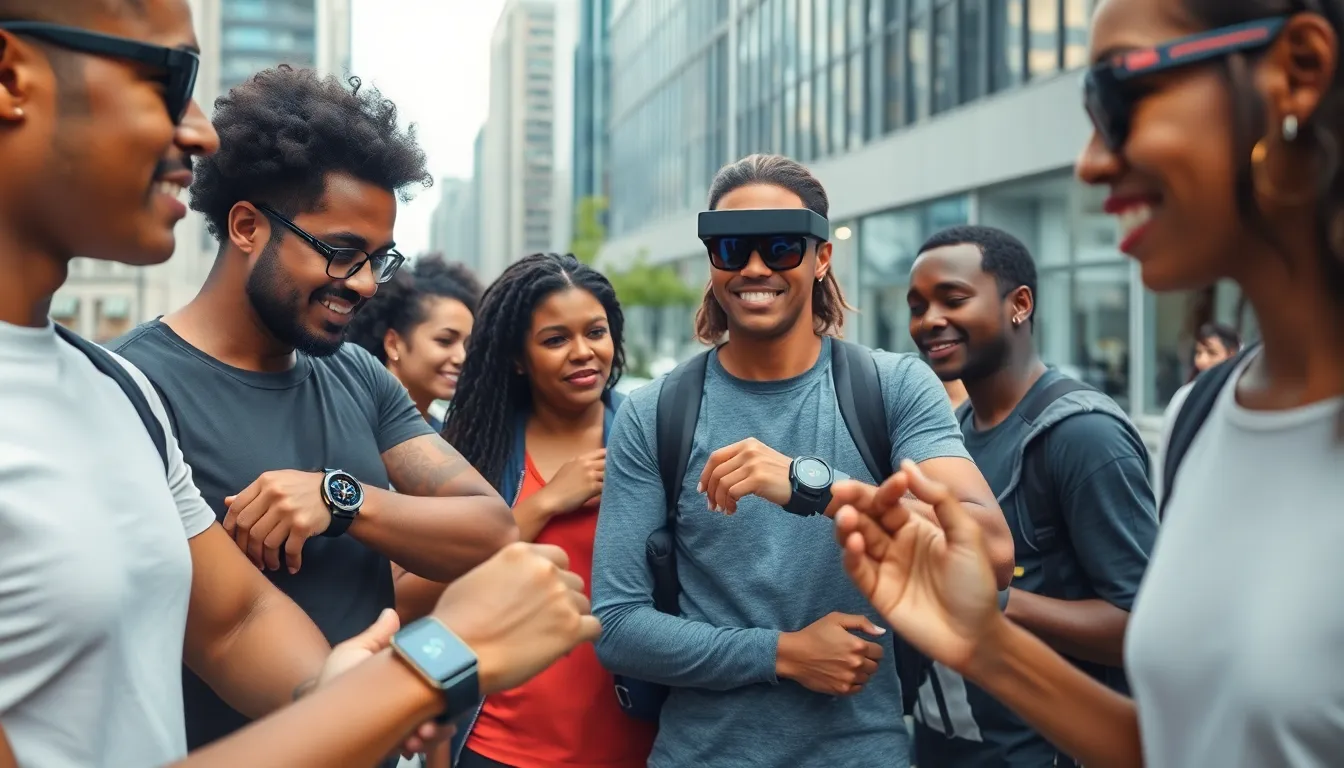In today’s fast-paced world, tech wearables have emerged as essential gadgets that seamlessly blend functionality with style. From smartwatches to fitness trackers, these devices are revolutionizing how people monitor their health, stay connected, and enhance their daily lives. As technology evolves, wearables are becoming smarter, more intuitive, and increasingly integrated into everyday routines.
With features that track heart rate, sleep patterns, and even stress levels, tech wearables empower users to take charge of their well-being. They not only provide valuable insights but also motivate individuals to achieve their fitness goals. As the market continues to expand, understanding the latest trends and innovations in tech wearables can help consumers make informed choices that align with their lifestyles.
Table of Contents
ToggleOverview of Tech Wearables
Tech wearables include devices like smartwatches, fitness trackers, and augmented reality glasses. These gadgets integrate advanced technology into everyday attire, enhancing both functionality and convenience.
Health Monitoring
Wearables track health metrics such as heart rate, steps taken, calories burned, and sleep patterns. Individuals use this data to monitor their well-being and adjust habits. For instance, fitness trackers encourage users to achieve daily step goals and maintain active lifestyles.
Connectivity Features
Tech wearables facilitate seamless communication. Users receive notifications for calls, messages, and app alerts directly on their wrists. Smartwatches connect to smartphones, allowing users to manage tasks without taking their devices out.
Fashion and Customization
Wearables combine practicality with style. Many manufacturers offer customizable options, enabling users to select watch faces, bands, and colors that match personal preferences. This personalization makes tech wearables fashionable accessories.
Market Growth
The tech wearables market continues to expand. Analysts predict an annual growth rate of 23% from 2023 to 2028. This increase reflects rising consumer interest in health and fitness technology.
Integration with IoT
Wearables increasingly connect with the Internet of Things (IoT), allowing for synchronized data sharing among devices. This integration enhances user experience, enabling smart home controls and automated settings.
By understanding the various aspects of tech wearables, consumers can make informed decisions that align with their lifestyles and wellness goals.
Types of Tech Wearables

Tech wearables encompass various devices designed to improve health, fitness, and connectivity. The following categories represent key types of wearables currently available in the market.
Smartwatches
Smartwatches offer advanced functionality beyond basic timekeeping. They integrate fitness tracking, health monitoring, and seamless communication features. Users can receive notifications for calls, texts, and app alerts directly on their wrist. Popular models include the Apple Watch, Samsung Galaxy Watch, and Fitbit Smartwatches, providing options that cater to different user preferences. Many smartwatches include heart rate sensors, GPS, and customizable watch faces, allowing individuals to personalize their experience.
Fitness Trackers
Fitness trackers focus primarily on health and activity monitoring. These devices track metrics such as steps taken, calories burned, distance traveled, and sleep patterns. Brands like Fitbit, Garmin, and Polar offer fitness trackers suited for various physical activities. Advanced models incorporate heart rate monitoring, hydration tracking, and even blood oxygen level measurements. By providing real-time feedback, fitness trackers empower users to develop healthier habits and reach their fitness goals.
Smart Glasses
Smart glasses present a unique interface between technology and daily life. These wearables allow users to access information hands-free through augmented reality (AR) or heads-up displays (HUD). Google Glass and Microsoft HoloLens exemplify how smart glasses can enhance productivity in professional settings or enrich consumer experiences. Features such as navigation aids, notifications, and voice commands add significant functionality. Smart glasses continue to evolve, showing potential in diverse fields like healthcare, education, and entertainment.
Features and Benefits of Tech Wearables
Tech wearables offer diverse features that enhance both health and connectivity. These devices combine advanced technology with everyday usability, providing significant benefits for users.
Health Monitoring
Health monitoring serves as a cornerstone feature of tech wearables. Devices like fitness trackers and smartwatches measure vital metrics, including heart rate, steps taken, calories burned, and sleep quality. For instance, the Apple Watch uses sensors to monitor heart rhythm and alert users to irregularities, promoting timely medical consultation. Wearables provide personalized insights that empower users to manage their health and achieve fitness goals effectively. Regular health tracking encourages proactive lifestyle adjustments, leading to improved overall well-being.
Connectivity and Integration
Connectivity and integration enhance the functionality of tech wearables. These devices connect seamlessly with smartphones and other connected gadgets, enabling users to receive notifications for calls, messages, and app alerts on a single platform. Brands leverage the Internet of Things (IoT) for synchronized data sharing, fostering a cohesive user experience. For example, wearable devices can sync with home automation systems, allowing users to control smart home features through voice commands or simple taps. This level of integration streamlines daily tasks, promoting efficiency and convenience in users’ lives.
Popular Tech Wearable Brands
Several brands dominate the tech wearable market, providing innovative products that meet diverse consumer needs.
Apple
Apple’s smartwatches, such as the Apple Watch Series 8, integrate health monitoring, notifications, and app functionality. These devices emphasize style and usability, appealing to a wide audience.
Samsung
Samsung Galaxy Watches, including the Galaxy Watch 5, offer advanced fitness tracking and seamless smartphone integration. These watches feature customizable designs and extensive health metrics, making them popular among users.
Fitbit
Fitbit specializes in fitness trackers like the Charge 5 and Inspire 3. These devices focus on health metrics, offering insights into activity, sleep patterns, and heart health. Fitbit promotes a community-driven approach, encouraging users to achieve wellness goals.
Garmin
Garmin produces fitness wearables tailored for athletes and outdoor enthusiasts. Models like the Forerunner 255 and Venu 2 provide specialized tracking for various sports, ensuring users receive accurate performance data.
Xiaomi
Xiaomi manufactures budget-friendly wearables, including the Mi Band series. These fitness trackers focus on essential health metrics and offer long battery life, appealing to cost-conscious consumers.
Huawei
Huawei’s wearables, such as the Watch GT 3, deliver robust health monitoring and battery efficiency. These devices combine sleek design with advanced features, catering to users who prioritize aesthetics and functionality.
Google’s entry into the market includes the Fitbit acquisition and the Pixel Watch. These products integrate Google’s software ecosystem, enhancing connectivity and user experience with smart features.
Amazfit
Amazfit offers an array of affordable smartwatches and fitness trackers, focusing on impressive battery life and diverse fitness features. The Bip U Pro and GTR 3 attract users seeking value without sacrificing performance.
These brands contribute significantly to the evolution of tech wearables, each providing unique features that cater to different needs and preferences.
Future Trends in Tech Wearables
Tech wearables are entering a new phase of innovation that promises to further enhance user experiences. Advancements in artificial intelligence (AI) integrate more personalized features into wearables, allowing them to learn user behaviors and preferences. This integration optimizes recommendations related to health and fitness, adapting to individual needs.
Wearables are becoming more multifunctional, merging health monitoring with everyday applications. For instance, smartwatches will increasingly incorporate features like medication reminders and stress management tools. The focus on holistic well-being will drive the development of devices that support mental health alongside physical fitness.
The incorporation of augmented reality (AR) into smart glasses will expand dramatically. Users will access enhanced information overlays for navigation, real-time translation, and immersive experiences. As companies refine AR technology, smart glasses will transition from niche products to essential tools in various sectors, including healthcare and education.
Battery life improvements remain a critical focus. Future wearables are set to utilize advanced battery technologies, such as solar charging or fuel cells. These innovations will extend usage time significantly, reducing the frequency of recharging and improving convenience for users.
Moreover, security concerns related to data privacy are now paramount. Wearable manufacturers are prioritizing stronger encryption and data protection measures. Enhanced security features will help build consumer trust as wearables handle increasingly sensitive health information.
The future will also see significant growth in fashion-forward wearables. Collaborations between tech companies and fashion brands will result in stylish devices that maintain functionality while appealing to aesthetic sensibilities. This trend ensures that wearables remain not only practical but also complementary to personal style.
Expanding interoperability with smart home devices and the Internet of Things (IoT) will advance significantly. Wearables will act as central hubs, enabling seamless control over various devices, from home security to health appliances. Enhanced connectivity will foster smarter living environments, driving user engagement with technology.
The tech wearable landscape is evolving rapidly, and staying informed about these trends empowers consumers to choose devices that align with their lifestyles and preferences.
Tech wearables are revolutionizing how individuals approach health and connectivity. As these devices evolve they not only enhance daily routines but also empower users to take charge of their well-being. With advancements in technology and design consumers have a wealth of options to choose from that fit their unique lifestyles.
The future promises even greater integration of AI and AR in wearables making them indispensable tools for managing health and enhancing everyday tasks. Staying updated on trends and innovations will be crucial for anyone looking to maximize the benefits of tech wearables. Embracing these devices can lead to a more connected and health-conscious lifestyle.



